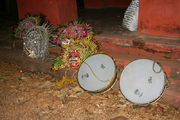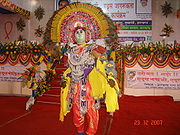
Chhau dance
Encyclopedia
Chhau dance is a genre of India
n tribal martial
dance which is popular in the India
n states of Orissa
, Jharkhand
and West Bengal
. There are three subgenres of the dance, based on its places of origin and development, Seraikella Chhau, Mayurbhanj Chhau and Purulia Chhau.
Seraikella Chhau was developed in Seraikela, the present day administrative headquarters of the Seraikela Kharsawan district of Jharkhand, Purulia Chau was developed in Purulia district
of West Bengal and Mayurbhanj Chhau was developed in Mayurbhanj district
of Orissa. The most prominent difference among the three subgenres is in the use of mask. While, the Seraikela and Purulia subgenres of Chhau use masks, the Mayurbhanj Chhau uses none.
, it is derived from Chhauni (military camp).

 The subgenre of Chhau performed in Purulia district and Jhargram subdivision
The subgenre of Chhau performed in Purulia district and Jhargram subdivision
of Paschim Medinipur District in West Bengal state, is referred to as the Purulia Chhau. It has a distinctive character of its own. It has received international acclaim and scaled rare heights of beauty and perfection. The approved theme of the West Bengal tableaux in the 1995 Republic Day celebrations at New Delhi was Chhau dance. Essentially a festival dance, Chhau was originally performed on the occasion of the Sun Festival towards the end of the month of Chaitra
(March–April). The situation has changed with time, as Chhau is now performed during some other festivals and at other times of year as well.
The Chhau dance is epical in content, and is based on various episodes of the Ramayana
and the Mahabharata
. Sometimes certain episodes of the Puranas
are also used. The dominant rasas are Vira and Rudra. In the end, generally, forces of evil are vanquished and the righteous triumphs. In the villages, no dais or raised platform is used; the dance takes place on the ground around which, the spectators sit in a circle. When performing outside their villages the dancers often use the stage. The dance, opens with the beating of drums followed by an invocation to Ganesha
. by a singer. As soon as the singer finishes the song, host of drummers and musicians step in creates an in inexplicably wonderful environ prior to the dance. Ganesha appears followed in quick succession by other characters —gods, demons, animals and birds.
India
India , officially the Republic of India , is a country in South Asia. It is the seventh-largest country by geographical area, the second-most populous country with over 1.2 billion people, and the most populous democracy in the world...
n tribal martial
Martial
Marcus Valerius Martialis , was a Latin poet from Hispania best known for his twelve books of Epigrams, published in Rome between AD 86 and 103, during the reigns of the emperors Domitian, Nerva and Trajan...
dance which is popular in the India
India
India , officially the Republic of India , is a country in South Asia. It is the seventh-largest country by geographical area, the second-most populous country with over 1.2 billion people, and the most populous democracy in the world...
n states of Orissa
Orissa
Orissa , officially Odisha since Nov 2011, is a state of India, located on the east coast of India, by the Bay of Bengal. It is the modern name of the ancient nation of Kalinga, which was invaded by the Maurya Emperor Ashoka in 261 BC. The modern state of Orissa was established on 1 April...
, Jharkhand
Jharkhand
Jharkhand is a state in eastern India. It was carved out of the southern part of Bihar on 15 November 2000. Jharkhand shares its border with the states of Bihar to the north, Uttar Pradesh and Chhattisgarh to the west, Orissa to the south, and West Bengal to the east...
and West Bengal
West Bengal
West Bengal is a state in the eastern region of India and is the nation's fourth-most populous. It is also the seventh-most populous sub-national entity in the world, with over 91 million inhabitants. A major agricultural producer, West Bengal is the sixth-largest contributor to India's GDP...
. There are three subgenres of the dance, based on its places of origin and development, Seraikella Chhau, Mayurbhanj Chhau and Purulia Chhau.
Seraikella Chhau was developed in Seraikela, the present day administrative headquarters of the Seraikela Kharsawan district of Jharkhand, Purulia Chau was developed in Purulia district
Purulia District
Purulia district is one of the nineteen districts of West Bengal state in eastern India. The town of Purulia is the administrative headquarters of the district.-History:...
of West Bengal and Mayurbhanj Chhau was developed in Mayurbhanj district
Mayurbhanj District
Mayurbhanj district is one of the 30 districts in Orissa state in eastern India. It is the largest district of Orissa by area. Baripada city is the district headquarters. As of 2011 it is the third most populous district of Orissa , after Ganjam and Cuttack.-History:Mayurbhanj District was formed...
of Orissa. The most prominent difference among the three subgenres is in the use of mask. While, the Seraikela and Purulia subgenres of Chhau use masks, the Mayurbhanj Chhau uses none.
Etymology
It is believed by some modern scholars that, the word Chhau, is derived from Sanskrit Chāya (shadow, image or mask), but according to Sitakant MahapatraSitakant Mahapatra
Sitakant Mahapatra is a notable Indian poet and literary critic in Oriya as well as English. He has also been in the Indian Administrative Service since 1961 until retiring in 1995, and has since held ex-officio posts such as the Chairman of National Book Trust, New Delhi.He is the first Oriya to...
, it is derived from Chhauni (military camp).
Purulia Chhau


Jhargram subdivision
Jhargram subdivision , is a subdivision of the Paschim Medinipur district in the state of West Bengal, India. It consists of Jhargram municipality and eight community development blocks: Binpur–I, Binpur–II, Jamboni, Jhargram, Gopiballavpur–I, Gopiballavpur–II, Nayagram and...
of Paschim Medinipur District in West Bengal state, is referred to as the Purulia Chhau. It has a distinctive character of its own. It has received international acclaim and scaled rare heights of beauty and perfection. The approved theme of the West Bengal tableaux in the 1995 Republic Day celebrations at New Delhi was Chhau dance. Essentially a festival dance, Chhau was originally performed on the occasion of the Sun Festival towards the end of the month of Chaitra
Chaitra
Chaitra is a month of the Hindu calendar....
(March–April). The situation has changed with time, as Chhau is now performed during some other festivals and at other times of year as well.
The Chhau dance is epical in content, and is based on various episodes of the Ramayana
Ramayana
The Ramayana is an ancient Sanskrit epic. It is ascribed to the Hindu sage Valmiki and forms an important part of the Hindu canon , considered to be itihāsa. The Ramayana is one of the two great epics of India and Nepal, the other being the Mahabharata...
and the Mahabharata
Mahabharata
The Mahabharata is one of the two major Sanskrit epics of ancient India and Nepal, the other being the Ramayana. The epic is part of itihasa....
. Sometimes certain episodes of the Puranas
Puranas
The Puranas are a genre of important Hindu, Jain and Buddhist religious texts, notably consisting of narratives of the history of the universe from creation to destruction, genealogies of kings, heroes, sages, and demigods, and descriptions of Hindu cosmology, philosophy, and geography.Puranas...
are also used. The dominant rasas are Vira and Rudra. In the end, generally, forces of evil are vanquished and the righteous triumphs. In the villages, no dais or raised platform is used; the dance takes place on the ground around which, the spectators sit in a circle. When performing outside their villages the dancers often use the stage. The dance, opens with the beating of drums followed by an invocation to Ganesha
Ganesha
Ganesha , also spelled Ganesa or Ganesh, also known as Ganapati , Vinayaka , and Pillaiyar , is one of the deities best-known and most widely worshipped in the Hindu pantheon. His image is found throughout India and Nepal. Hindu sects worship him regardless of affiliations...
. by a singer. As soon as the singer finishes the song, host of drummers and musicians step in creates an in inexplicably wonderful environ prior to the dance. Ganesha appears followed in quick succession by other characters —gods, demons, animals and birds.

